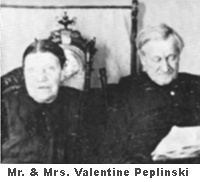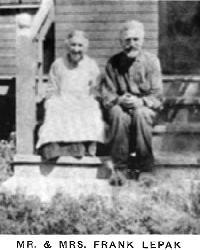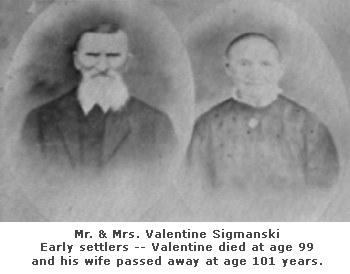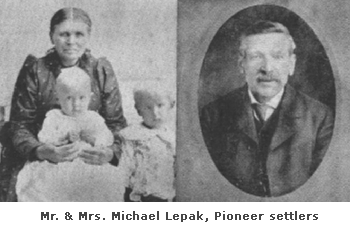|
The history of Saint
Stanislaus Church at Hofa Park, Wisconsin, would lack
the proper background if nothing were written about John
J. Hof after whom this village in northeastern
Wisconsin was named. Hofa Park was the beginning of a
movement conceived by Hof to settle northeastern
Wisconsin, particularly the counties of Shawano,
Outagamie, Brown and Oconto, with Polish immigrants. His
humble beginning here was crowned with the settling of
over one thousand Polish families at Hofa Park, Pulaski,
Sobieski, Kosciuszko and Krakow between the years 1877
and 1900.
Who was this man, John J.
Hof? Whence did he originate ? What was his interest in
Poles and Catholics? This is particularly interesting
since he himself was a Norwegian by birth and professed
the Lutheran religion until shortly before death, when
he became a Catholic.
Born in 1842 -- Little is
known about Hof's early life, the years he spent in his
native Norway and the exact year when he came to the
United States. We know that he was born in 1842 at
Domaas, Norway. This is definitely supported by evidence
today contradicting earlier writers (Fr. Venceslaus
Kruszka and Fr. Francis Manel, O.F.M.) who claimed that
Hof was a Swede. The events of the next thirty-three
years in Hof's life are shrouded in silence.
In the pamphlets which he
later published in the Polish language advertising his
land sales to the Poles of America, Hof wrote of his
extensive travels throughout the United States. His
purpose was to find suitable farm land upon which to
settle Polish immigrants, or so he claimed. Although
this statement must be taken with a grain of salt
because every land agent praised his territory as the
best, nevertheless the biographical element offered is
all that we have until we find Hof in Milwaukee,
Wisconsin, about the year 1875. At least, it indicates
Hof's early interest in land sales. Before undertaking
this career, he carefully investigated the prospects and
opportunities which existed in the country at the time
for settling immigrants on farms. His choice fell upon
Wisconsin.
Began Career as Land Agent
in Milwaukee
As far as is known at
present, Hof began his career as a land agent for the
General Land Office at Milwaukee in 1875. It was located
at 117-119 West Water Street (near today's intersection
of N. Plankinton and W. Clybourn Streets). No further
information has thus far been discovered which would
indicate more precisely the name of the land company in
whose employ Hof labored.
At the outset, it was not
to Poles but to his own Norwegian countrymen that Hof
first sold land in and around Seymour, in Outagamie
County of northeastern Wisconsin. This he did for a
period of two years, from 1875-1877. But he did not
enjoy a great success with his own countrymen, many of
whom left the Seymour area. It was then that Hof turned
to the Poles.
His Plan to Settle Poles
on Farms
In the summer of 1877, he
began to contact Polish families in Milwaukee, urging
them to settle on the cutover land near the future
village of Hofa Park in the town of Maple Grove, Shawano
County. He assured them that this would be the beginning
of his plan to settle many Poles on the lands he was
selling. If he were successful, more Polish colonies, as
he loved to call the Polish farm settlements, would
follow.
Hof openly professed his
intention to the pioneers of Hofa Park that he would
sell land only to the Poles. Later he also included the
Lithuanians and other nationalities. However, in the
case of the Lithuanians, they also spoke Polish because
of their union with Poland for over five hundred years
in one of Europe's earliest commonwealths. Nevertheless,
Hof sold the vast majority of his lands to the Poles and
thus remained true to his promise.
First Four Polish Families
at Hofa Park
Hof's salesmanship was so
convincing that four Polish families sold their homes in Milwaukee to him in exchange for land in the Hofa Park
area. In September, 1877, the families of Valentine
Peplinski, Frank and Michael Lepak, and of Valentine
Zygmanski arrived in the northwestern section of the
town of Maple Grove. A beginning for the establishment
of Polish colonies by Hof was now a reality.
Milwaukee to him in exchange for land in the Hofa Park
area. In September, 1877, the families of Valentine
Peplinski, Frank and Michael Lepak, and of Valentine
Zygmanski arrived in the northwestern section of the
town of Maple Grove. A beginning for the establishment
of Polish colonies by Hof was now a reality.
Some of Hof's Polish Aides
To assure himself of
greater success in settling Poles in northeastern
Wisconsin, Hof engaged Polish assistants, such as
interpreters, secretaries and part-time agents. The
earliest known of these Polish aides to Hof was Theo M,
Helinski. It was he who served as a contact between Hof
and the first four Polish families which came to Hofa
Park. Helinski was a notary public in Milwaukee. He also
served in this capacity for Hof as is proven by the
early deeds.
Next, there was Miss Helen
Rozanski, who served as secretary to Hof handling all
Polish correspondence between the years 1877 and 1900.
Other Poles serving as interpreters and agents for Hof
at different times during the years 1877 to 1910 were
Leo Gabryszek, Stanley B. Liberski, Edward Koldrowicz,
Stanley Piotrowski and A. S. Dominiczak.
Non-Polish Associates,
Remembered by Poles
Prominently associated
with Hof and well-remembered by the early Polish
settlers in Hof's colonies were
colonies were
such non-Poles as Thorace
Thompson, who also operated a sawmill at Hofa Park from
1885 and John N. Kurtz, notary public for the Hof Land
Co. from 1889. Hof also employed his own surveyor in the
person of William E. Weeks.
Although the above-named
Poles were more prominently associated with Hof in his
contact with the Polish immigrants, almost every Polish
family which was settled in the early years by Hof in
this area served as individual agents for him in his
Polish colonization program. The means used was
correspondence of the early settlers with their
relatives and friends in other parts of the United
States and even in Poland. An insatiable hunger and love
for the soil which they could call their own as well as
life among their own countrymen attracted many more to
Hof's colonies.
Huge Advertising Campaign
of Land Sales to Poles
Hof played masterfully
upon this yearning of the Polish immigrant. Beginning
with the year 1881, he organized a tremendous campaign
advertising the formation of his Polish colonies in the
farm regions of northeastern Wisconsin. In lots of five
thousand copies at a time, he published Polish land
maps and pamphlets gloriously describing the
opportunities which his lands offered for Polish
agricultural communities, markets for farm products,
transportation by rail and water. In one edition, he
assured the prospective settlers of the ultimate
provision of a large river which would flow between Hofa
Park and Green Bay!
Knowing the persuasiveness
of correspondence, Hof printed thousands of letters
listing the names of settlers already occupying land in
his colonies. In these letters, the settlers praised the
favorable conditions of life on the farms or land which
Hof sold them.
The land sales advertising
material of land maps, pamphlets and letters was written
and printed first by the Smulski Publishing Co., of
Chicago, Illinois, and a few years later (1888) by the Kuryer Polski Publishing Co., of
Milwaukee, Wisconsin. Records of copies surviving today
attest to this fact.
(1888) by the Kuryer Polski Publishing Co., of
Milwaukee, Wisconsin. Records of copies surviving today
attest to this fact.
Finally, Hof advertised
extensively in the Polish weekly and daily newspapers of
Milwaukee, Chicago and the cities of Pennsylvania and
New York where greater groups of Polish immigrants were
massed. The peak of this pamphlet and newspaper campaign
existed between the years 1885 and 1900 although Hof
still advertised in newspapers till 1905.
Brother Augustine Zeitz
and Hof
From the years 1886 to
1900, Hof also advertised his land sales in the
Lithuanian newspapers of the country. This was done
mainly through the advice and help of Brother Augustine
Zeitz, O.F.M., founder of the Franciscan Monastery at
Pulaski in 1887. Most of the ad copy as well as articles
on the progress of settlement in Hof's colonies were
written in the Lithuanian language by Brother Augustine
himself.
Again, the language
barrier was not great since most Lithuanians also spoke
Polish. For this reason, even Brother Augustine in
advertising the foundation of a Franciscan Monastery
opened its doors to Lithuanian as well as to Polish
candidates for the priesthood and brotherhood.
Various Surnames Used by
Hof
An oddity occurs in Hof's
use of various names during his early years as land
agent. Up to 1881, he generally used the name of John J. Hof although
that was not his true name. After Hof's death in 1910,
the surviving correspondence between his brother
Matthias in Norway and John N. Kurtz, the executor of
Hof's estate in America, reveals that Hof's real name
was Hofhaug. Matthias Hofhaug, who did not change his
name, informed the executor that his brother John
shortened the name to Hof after coming to the United
States.
1881, he generally used the name of John J. Hof although
that was not his true name. After Hof's death in 1910,
the surviving correspondence between his brother
Matthias in Norway and John N. Kurtz, the executor of
Hof's estate in America, reveals that Hof's real name
was Hofhaug. Matthias Hofhaug, who did not change his
name, informed the executor that his brother John
shortened the name to Hof after coming to the United
States.
To this shortened form Hof
added the name of Johnson in 1881 (probably sooner). On
August 3, 1881, the Green Bay Daily State Gazette
reported that "Mr. J. Hoff Johnson, of Milwaukee, spent
last week in town (Angelica). Mr. J. is in the land
agency. He has located a number of settlers in this town
and Lessor." Some of the early settlers, such as John
Lepak and John Peplinski, also testified to the author
of this history that Hof used the name of Johnson at
random in his early days as land agent.
Three Periods of Hof's
Activity in Land Sales
From the above, it appears
that Hof used both names interchangeably during the
years 1875 to 1881. This may have been a holdover from
his first attempt to settle Norwegian immigrants in the
Seymour area. But from the year 1881 to his death, his
land records, advertising material, stationery and deeds
list only the name of Hof or the John J. Hof Land Co.
In conjunction with the
use of various names, three periods of Hof's activity in
land sales may be distinguished. The first extends from
approximately the year 1875 to 1881. During this time,
Hof was predominantly a land agent in the employ of the
General Land Office of Milwaukee. From the commission
which he made on land sales, he purchased tracts of
wooded and semi-wooded, cutover land for himself.
During the second period
extending from the years 1881 to 1889, Hof operated as
the sole owner of the land he sold. He stressed this
fact in 1883 to Bishop Francis X. Krautbauer, of Green
Bay, to whom he donated land for the Hofa Park Catholic
church. Again, in a letter dated May 10, 1886, and
written to Bishop Frederick Katzer, successor to
Krautbauer in the diocese of Green Bay, Hof repeats that
he is the sole owner of the land he sells.
The John J. Hof Land
Company
In 1889, Hof became
president of the newly organized John J. Hof Land Co.,
incorporated in the state of Wisconsin. William Mariner
served as vice-president and John W. Mariner as
secretary-treasurer. John N. Kurtz was the notary public
for the company.
The Mariner brothers,
whose realty company still exists today in Milwaukee in
the building named after them (at 411 E. Mason St.),
previously owned the Northern Colonization Co. up to the
year 1887. Affiliated with them also were A. C. Conn,
Howard C. Gardner and William Herman, all of whom owned
large amounts of land in the Little Suamico, Sobieski,
Krakow and Seymour areas. It was from them that Hof
purchased much of his land prior to 1889. The formation
of the Hof Land Co. in 1889 together with the Mariners
may possibly hint that Hof worked as a land agent for
their Northern Colonization Co. during the 1875-1881
period. But no conclusive evidence exists to establish
this fact without doubt.
Strong Attachment of Poles
to Catholic Faith
Besides playing up to the
patriotic sentiment of the Poles in forming Polish farm
colonies, Hof catered to their strong attachment to the
Catholic Faith. Knowing that ninety-five per cent of the
Polish immigrants were Catholics, he printed
architectural sketches of churches on his early land
maps to show that Catholic temples of worship were
located in central positions of his rising settlements.
In 1887, similar sketches appeared on succeeding maps
depicting the first Franciscan monastery and church at
Pulaski. It was variously labeled as "Church at Hofa
Park and Pulaski," "Convent at Hofa Park and Pulaski,"
or simply "Pulaski Convent." All of Hof's land maps,
circulars, booklets, deeds, stationery and other
official papers bore this name of the churches from 1887
to 1897. From the latter year on, churches at Sobieski
and Krakow were added to the maps and advertising
literature.
Although Hof advertised
the presence of churches in the five colonies he
founded, the fact is that the settlers had to build
these churches themselves generally about five years
after their arrival in each settlement. In each case,
however, Hof donated the land and most of the timber for
these churches.
Disappointment of Early
Settlers
Not only were the early
settlers disappointed with the lack of churches when
they first arrived in the Hofa Park, Pulaski, Sobieski,
Kosciuszko and Krakow areas. Many were also
disillusioned by the condition of the land Hof sold
them. Meeting their gaze upon arrival were still quite
dense forests and brush, deep swamps or low and sandy
soil. The glorious picture painted in Hof's circulars
appeared quite different upon personal examination.
Though their
disappointment was heart-rending at times and their life
very primitive and rugged at the very outset, these
pioneers never lacked the will to work hard and to make
sacrifices despite a life of almost abject poverty.
Their love of the land and the sense of ownership
conquered all difficulties as they dug in to clear the
land and to begin farming on a modest scale.
Whatever claims and
promises were overstated by Hof, he was generous to the
settlers in other ways. He donated land, timber and
money towards the building of their churches. In his
transactions with the poor Polish immigrants who wended
their way to these settlements, he was patient and
reasonable. Selling his land at ten to fifteen dollars
an acre, he would wait beyond the term of payment of the
principal, often canceling the interest. He aided the
settlers personally after the terrible forest fires of
1886 in these areas. Thus, with encouragement and help
from Hof, these pioneers gradually prospered, built the
first roads, constructed churches and schools and
developed their farms to the efficient state which meets
the eye of the visitor to these settlements today.
Settlements Named after
Polish Heroes and Cities
With the exception of Hofa
Park, which he named after himself, Hof reached into the
past history of Poland to select national heroes and
cities for the names of his settlements. He did this
with the aid or at the suggestion of his Polish agents.
Pulaski, Kosciuszko and Sobieski were military heroes
and defenders of freedom either in Polish or both Polish
and early American history. Krakow was once the capital
of Poland in her greater days of glory. These national
heroes and the former capital of Poland were dear to the
hearts of the Polish immigrant who, settling on soil far
from his native country, felt more at home in a
Polish-named though modest farm community.
After meeting with
complete success in colonizing and firmly establishing
Polish settlements at Hofa Park and Pulaski, Hof opened
a branch land office of the John J. Hof Land Company at
Sobieski in 1894. This was done to spur land sales in
the Sobieski, Kosciuszko and Krakow areas. The main
office of this company still remained in Milwaukee.
Direct Railroad
Transportation to Sobieski
Following the opening of a
branch office at Sobieski, Hof succeeded in persuading
the Chicago, Milwaukee and St. Paul Railroad to transfer
its scheduled logging train stop from Gardner to
Sobieski, a distance of one mile and a half to the
north. Shortly thereafter, a depot was built at Sobieski.
Thus, all the Polish settlers from various parts of the
United States henceforth came directly through Chicago
and Milwaukee to Sobieski. Previously, the settlers of
Hofa Park or Pulaski detrained at Green Bay or Seymour
and either walked or were driven by horse and wagon a
distance of twenty to twenty-five miles to their
newly-purchased land! Before 1894, the nearest railroad
stop for Sobieski settlers was four miles further east
at Little Suamico, Wisconsin. The Sobieski railroad
station thus considerably shortened the distances of
foot or wagon travel for the Sobieski, Kosciuszko and
Krakow settlers.
This marked the earliest
direct transportation by railroad to Hof's Polish
settlements. Later, in 1906, similar transportation to
Pulaski and Krakow was provided by the Chicago and North
Western Railway. Hofa Park was never as fortunate.
Although attempts were made as early as 1870 to provide
railway transportation from Green Bay through Angelica,
near Hofa Park, and though Hof optimistically advertised
that trains would roll through Hofa Park, nothing ever
materialized in this regard. Later, transportation by
auto and shipping of farm products by truck lines
decreased the importance of a railroad in Hofa Park and
other farm communities.
Over 160,000 Acres of Land
Predominantly Settled by Poles
Both the branch land
office and direct railroad transportation to Sobieski
represent Hof's final success in populating over 160,000
acres of land with predominantly Polish farmers. His
dream of establishing Polish farm colonies was well
realized even before his death. The initial success he
had with luring four Polish families to Hofa Park in
1877 was followed by similar modest beginnings of new
Polish settlements at Pulaski in 1883, Sobieski in 1892,
Kosciuszko and Krakow in 1895. Kosciuszko, however,
never developed into a thriving community.
Within five to ten years
after the first settlers arrived, churches were built in
Hofa Park (1883), Pulaski (1887), Sobieski (1897) and
Krakow (1903). Previous construction of essential places
of business and trade contributed to the gradual
formation of villages that now dot this area. |